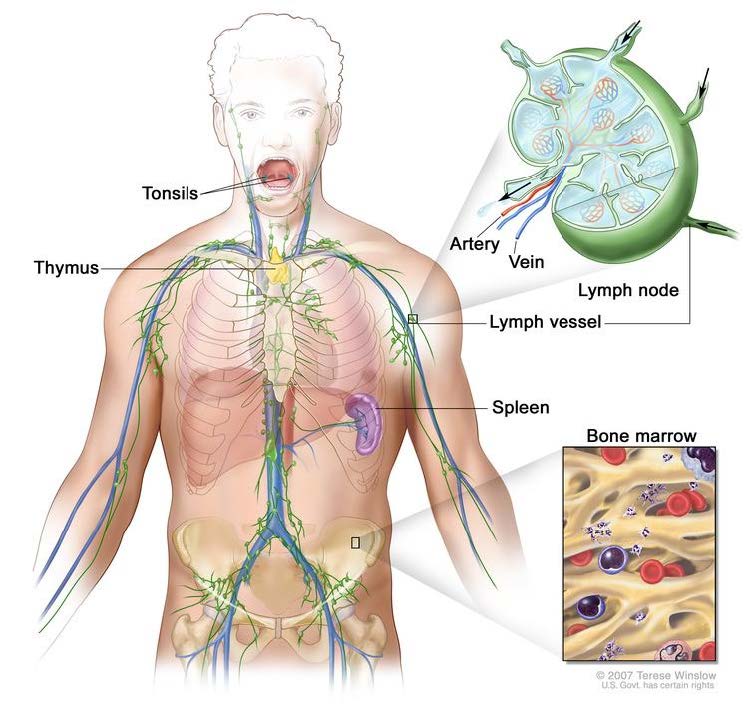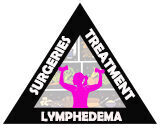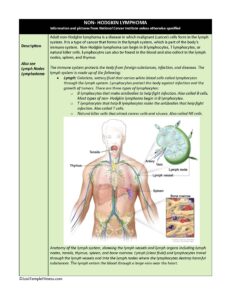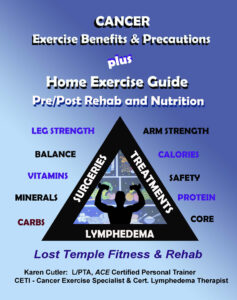Non-Hodgkin Lymphoma
Your Body is Your Temple
Research, Resources & Education
Table of Contents
Non-Hodgkin lymphoma is a type of cancer that affects the body's immune system, specifically the lymphatic system, which is responsible for fighting infections and diseases. The condition causes the growth of abnormal cells in the lymphatic system, leading to the formation of tumors. Among the symptoms that one may experience are swollen lymph nodes, fever, fatigue, unexpected weight loss, and night sweats. There are treatment options available for non-Hodgkin lymphoma, such as chemotherapy, radiation therapy, and immunotherapy.
Information and pictures from National Cancer Institute unless otherwise specified
Lymphoma and Lymph Anatomy

Adult non-Hodgkin lymphoma is a disease in which malignant (cancer) cells form in the lymph system.
- It is a type of cancer that forms in the lymph system, which is part of the body’s immune system.
- Non-Hodgkin lymphoma can begin in B lymphocytes, T lymphocytes, or natural killer cells.
- Lymphocytes can also be found in the blood and also collect in the lymph nodes, spleen, and thymus
The immune system protects the body from foreign substances, infection, and diseases.
The lymph system is made up of the following:
- Lymph: Colorless, watery fluid that carries white blood cells called lymphocytes through the lymph system.
- Lymphocytes protect the body against infection and the growth of tumors.
- There are three types of lymphocytes:
- B lymphocytes that make antibodies to help fight infection. Also called B cells. Most types of non- Hodgkin lymphoma begin in B lymphocytes.
- T lymphocytes that help B lymphocytes make the antibodies that help fight infection. Also called T cells.
- Natural killer cells that attack cancer cells and viruses. Also called NK cells.
(See Pic)
Anatomy of the lymph system, showing the lymph vessels and lymph organs including lymph nodes, tonsils, thymus, spleen, and bone marrow.
- Lymph (clear fluid) and lymphocytes travel through the lymph vessels and into the lymph nodes where the lymphocytes destroy harmful substances.
- The lymph enters the blood through a large vein near the heart.
- Lymph vessels: A network of thin tubes that collect lymph from different parts of the body and return it to the bloodstream.
- Lymph nodes: Small, bean-shaped structures that filter lymph and store white blood cells that help fight infection and disease.
- Lymph nodes are located along the network of lymph vessels found throughout the body.
- Clusters of lymph nodes are found in the neck, underarm, abdomen, pelvis, and groin.
- Spleen: An organ that makes lymphocytes, filters the blood, stores blood cells, and destroys old blood cells.
- Thymus: An organ in which lymphocytes grow and multiply
- Tonsils: Two small masses of lymph tissue at the back of the throat. The tonsils make lymphocytes.
- Bone marrow: The soft, spongy tissue in the center of large bones.
- Bone marrow makes white blood cells, red blood cells, and platelets.
- Lymph tissue is also found in other parts of the body such as the stomach, thyroid gland, brain, and skin.
- Cancer can spread to the liver and lungs.
Lymphoma Videos
YouTube Videos that help explain types of Lymphoma.
Disclaimer:
This is for research only and Lost Temple Fitness & Cancer does not endorse any video presented on this website.
It is advised that you ALWAYS CHECK WITH YOUR PHYSICIAN for a proper diagnosis and treatment plan.
Indolent vs Aggressive Lymphoma
Non-Hodgkin lymphoma grows and spreads at different rates and can be indolent or aggressive. The treatments for indolent and aggressive lymphoma are different.
Indolent Lymphoma
Aggressive Lymphoma
Treatments
Also see Treatments
Intrathecal chemotherapy may also be used in the treatment of lymphoma that first forms in the testicles or sinuses (hollow areas) around the nose, diffuse large B-cell lymphoma, Burkitt lymphoma, lymphoblastic lymphoma, and some aggressive T-cell lymphomas.
- It is given to lessen the chance that lymphoma cells will spread to the brain and spinal cord. This is called CNS prophylaxis.
The type of surgery used depends on where the lymphoma formed in the body:
- Local excision for certain patients with mucosa-associated lymphoid tissue (MALT) lymphoma, PTLD, and small bowel T-cell lymphoma.
- Splenectomy for patients with marginal zone lymphoma of the spleen.
- Small bowel surgery is often needed to diagnose celiac disease in adults who develop a type of T-cell lymphoma.
- If the blood becomes thick with extra antibody proteins and affects circulation, plasmapheresis is done to remove extra plasma and antibody proteins from the blood.
- In this procedure, blood is removed from the patient and sent through a machine that separates the plasma (the liquid part of the blood) from the blood cells.
- The patient’s plasma contains the unneeded antibodies and is not returned to the patient.
- The normal blood cells are returned to the bloodstream along with donated plasma or a plasma replacement.
- Plasmapheresis does not keep new antibodies from forming.
Radiation therapy
Targeted therapy
Immunotherapy
Watchful waiting
Antibiotic therapy
Stem cell transplant
Chemotherapy
Immunotherapy
Possible Side Effects & Risk Factors
Possible Side Effects
- Heart problems.
- Infertility
- Loss of bone density.
- Neuropathy (nerve damage that causes numbness or trouble walking).
- Patients who have a heart, lung, liver, kidney, or pancreas transplant usually need to take drugs to suppress their immune system for the rest of their lives.
- Long-term immunosuppression after an organ transplant can cause a certain type of non-Hodgkin lymphoma called post-transplant lymphoproliferative disorder (PLTD).
- A second cancer, such as:
- Lung cancer.
- Brain cancer.
- Kidney cancer.
- Bladder cancer.
- Melanoma.
- Hodgkin lymphoma.
- Myelodysplastic syndrome.
- Acute myeloid leukemia.
Risk Factors
- Being older, male, or White.
- Having one of the following medical conditions that weakens the immune system:
- An inherited immune disorder (such as hypogammaglobulinemia or Wiskott-Aldrich syndrome).
- An autoimmune disease (such as rheumatoid arthritis, psoriasis, or Sjögren syndrome).
- HIV/AIDS.
- Human T-lymphotrophic virus type I or Epstein-Barr virus infection.
- Helicobacter pylori infection.
- Taking immunosuppressant drugs after an organ transplant.
Disclaimer: The information in this book/website is for educational purposes only and has been obtained through research, publications and personal experience, and shall not be liable for incorrect information. Any mentioned publications or websites does not imply endorsement. As this industry is ever changing, I urge readers to confirm the information contained in this book/website. The author will not be liable for any injuries sustained from practicing techniques taught or for any typographical errors or omissions.
It is advised that you always check with your medical doctor or physical therapist before starting an exercise program or change in diet.
|
Information and pictures from National Cancer Institute unless otherwise specified |




